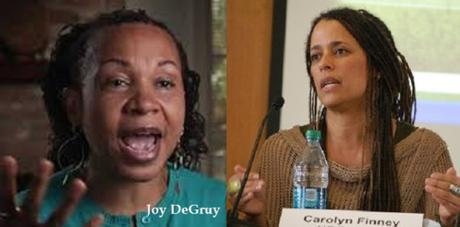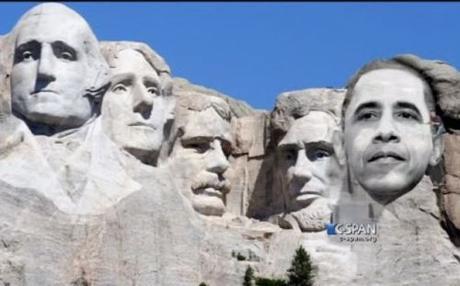The mind of the Left is a strange thing.
The way it works is this: If a racial/ethnic group is "underrepresented" in some institution, place or activity, the reason must be overt or covert racism.
Being "underrepresented" means a group is not found in the same number or percentage in a particular institution/place/activity as they are in the larger, national population. For example, since blacks comprise about 13% of the U.S. population but not 13% of university admissions, the Left say it is because of "institutional" racism. Of course, it never works the other way around: although blacks are grossly over-represented in professional basketfall, there's no anti-white or anti-Asian racism there!
The latest accusation of "racism based on underrepresentation" has to do with the low attendance of blacks and other "people of color" in America's national parks.
Indeed, if you've visited national parks and monuments, you probably have noticed the scarcity of blacks. The reason, we are now told, is that national parks are a white thing, and trees are racist. Those making the racist accusation include a black Congressman, a black federal government bureaucrat, and two black professors.
(1) Congressman Alcee L. Hastings (D-Florida)
On April 18, 2016, Rep. Alcee L. Hastings and 35 other Democratic Congresspeople sent a letter urging the National Park Service (NPS) to be more "diverse" and "inclusive". The letter says:
"Historically, and the environmental community have been perceived as exclusionary and the domain of primarily wealthy white Americans. [...]
We are greatly concerned by low attendance from African Americans and other communities of color. And while Latinos are the fastest-growing group in the United States, only 1 in 10 National Park visitors is Latino. Recent studies have revealed that non-visiting communities of color do not visit NPS parks or monuments because of the lack of information of NPS units, and because of perceptions that NPS units are unsafe, unpleasant, or provided poor service. It is clear that meaningful and targeted outreach is required.
While the beauty of the preserved natural settings within is attractive to all Americans, the historical setting can be off-putting to people who do not feel that their history is being celebrated or adequately represented. According to a recent Center for American Progress analysis, of the more than 400 national parks and monuments in the NPS system, only about one-quarter have a primary focus on women, communities of color, or other traditinally underrepresented groups."
In effect, Hastings, et al. 's letter is saying blacks and other non-whites don't visit national parks because those parks are racist because:
- They are a white thing, in that historically - and today - primarily rich white people visit national parks.
- Most national parks and monuments don't have a "primary focus" (whatever that means) on blacks, non-whites, women and other "excluded" groups. (Just you wait, they'll be demanding an LGBT national monument next.)
- All of which accounts for why blacks don't "feel safe" and welcome in national parks.
The letter's 36 signatories then ask the director of NPS to provide information on what measures he's undertaken to attract "more ethnically diverse employment applicants to the NPS," such as outreach programs directed at "communities of color" to increase their attendance, and other plans to appeal to "underrepresented communities". In other words, the letter is simply a ploy for yet another federal program and bureaucracy, staffed by blacks.
(2) NPS Deputy Director Mickey Fearn
 Former manager of the City of Seattle's Race and Social Justice Initiative, Mickey Fearn was appointed by the Obama administration and served as the National Park Service Deputy Director for Communications and Community Assistance (i.e., a "community organizer" to "outreach" to blacks) from 2009 to 2013.
Former manager of the City of Seattle's Race and Social Justice Initiative, Mickey Fearn was appointed by the Obama administration and served as the National Park Service Deputy Director for Communications and Community Assistance (i.e., a "community organizer" to "outreach" to blacks) from 2009 to 2013.
In March 2010, Fearn was the guest speaker at the Recreation Exchange hosted by the American Recreation Coalition. He said some interesting things, including:
- "Traditionally, the national parks were based on the European concept of tourism , meaning that parks were a destination vacation where people had to travel far to see them and often stayed in remote locations." (It's a white thing.)
- "We also have to recognize the barriers that keep non-park users from coming out , and some of those reasons can be related to fear of the unknown ." (Blacks don't visit national parks 'cause they're scared. But of what? See #3 below.)
- Fearn attributed his own children's lack of "outdoor experiences" while growing up to his "fear of rural racial violence from his own youth spent in the South."
By "rural racial violence in the South," Fearn was referring to the of blacks. What is it about national parks that could provoke this "fear of rural racial violence"? What is found in "rural" areas?
In other words, Fearn attributes blacks' avoidance of national parks to trees - trees that remind them of lynching, of blacks being hung from trees. Never mind that no black person in America today has personally experienced slavery or lynching.
(3) post traUMATIC SLAVE SYNDROME
This is where two black academics come in - Carolyn Finney and Joy DeGruy - with the concept of "post-traumatic slave syndrome".
 In her 2005 book, Post Traumatic Slave Syndrome: America's Legacy of Enduring Injury and Healing, Joy DeGruy (née Leary), who teaches social work at Portland State University, claims that centuries of slavery in the United States , followed by systemic and structural racism and oppression, including lynching, Jim Crow laws, and unjust incarceration, have resulted in the post traumatic slave syndrome (PTSS) - a multi-generational trauma and set of maladaptive behaviors, beliefs and actions that originated as survival strategies. The syndrome continues because children whose blacks parents suffer from PTSS are often indoctrinated into the same behaviors, long after the behaviors have lost their original purpose.
In her 2005 book, Post Traumatic Slave Syndrome: America's Legacy of Enduring Injury and Healing, Joy DeGruy (née Leary), who teaches social work at Portland State University, claims that centuries of slavery in the United States , followed by systemic and structural racism and oppression, including lynching, Jim Crow laws, and unjust incarceration, have resulted in the post traumatic slave syndrome (PTSS) - a multi-generational trauma and set of maladaptive behaviors, beliefs and actions that originated as survival strategies. The syndrome continues because children whose blacks parents suffer from PTSS are often indoctrinated into the same behaviors, long after the behaviors have lost their original purpose.
Conveniently, according to DeGruy, PTSS is not a disorder that can simply be treated and remedied clinically but rather requires profound social change in in America's institutions. (Translated, this means more federal government legislation, programs, bureaucracies, and employment for blacks.)
DeGruy's PTSS notion was picked up by another academic, Carolyn Finney , professor of geography at the University of Kentucky, to explain why blacks don't frequent national parks.
In her 2014 book, Black Faces, White Spaces: Reimagining the Relationship of African Americans to the Great Outdoors, Finney asks "Why are African Americans so underrepresented when it comes to interest in nature, outdoor recreation, and environmentalism?" Her answer is post traumatic slave syndrome - "the legacies of slavery, Jim Crow, and racial violence have shaped cultural understandings of the 'great outdoors' and determined who should and can have access to natural spaces."
In other words, national parks are a white thing, and blacks don't do national parks because of racism, or as Finney puts it: "the perceived and real ways in which nature and the environment are racialized in America."
is on the U.S. National Parks Advisory Board "working to assist the National Park Service in engaging in relations of reciprocity with diverse communities."
The gist of all this is that in America today - 153 years after Abraham Lincoln's Emancipation abolishing slavery, and 56 years after the Civil Rights Act of 1960 - blacks are still traumatized by slavery (post traumatic slave syndrome); there is still overt and covert racism everywhere, including in our national parks system; and whatever "maladaptive" beliefs and behaviors of blacks are all somebody else's fault.
Just you wait: Since Obama was first elected president, some of us have joked that his visage will be added to Mount Rushmore. I don't think it should be dismissed as a joke.
The next wave of scrubbing America's obstinate racism is already here - that of accusing our national parks and monuments of racism, and the concomitant movement to make them more "diverse" and "inclusive". And where better to begin that movement to "diversify" our national parks and monuments than Mount Rushmore?
 H/t Frontpage Magazine and FOTM 's maziel.
H/t Frontpage Magazine and FOTM 's maziel.
See also:

